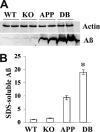GRK5 deficiency accelerates {beta}-amyloid accumulation in Tg2576 mice via impaired cholinergic activity
- PMID: 21041302
- PMCID: PMC3009881
- DOI: 10.1074/jbc.M110.170894
GRK5 deficiency accelerates {beta}-amyloid accumulation in Tg2576 mice via impaired cholinergic activity
Abstract
Membrane G protein-coupled receptor kinase 5 (GRK5) deficiency is linked to Alzheimer disease, yet its precise roles in the disease pathogenesis remain to be delineated. We have previously demonstrated that GRK5 deficiency selectively impairs desensitization of presynaptic M2 autoreceptors, which causes presynaptic M2 hyperactivity and inhibits acetylcholine release. Here we report that inactivation of one copy of Grk5 gene in transgenic mice overexpressing β-amyloid precursor protein (APP) carrying Swedish mutations (Tg2576 or APPsw) resulted in significantly increased β-amyloid (Aβ) accumulation, including increased Aβ(+) plaque burdens and soluble Aβ in brain lysates and interstitial fluid (ISF). In addition, secreted β-APP fragment (sAPPβ) also increased, whereas full-length APP level did not change, suggesting an alteration in favor of β-amyloidogenic APP processing in these animals. Reversely, perfusion of methoctramine, a selective M2 antagonist, fully corrected the difference between the control and GRK5-deficient APPsw mice for ISF Aβ. In contrast, a cholinesterase inhibitor, eserine, although significantly decreasing the ISF Aβ in both control and GRK5-deficient APPsw mice, failed to correct the difference between them. However, combining eserine with methoctramine additively reduced the ISF Aβ further in both animals. Altogether, these findings indicate that GRK5 deficiency accelerates β-amyloidogenic APP processing and Aβ accumulation in APPsw mice via impaired cholinergic activity and that presynaptic M2 hyperactivity is the specific target for eliminating the pathologic impact of GRK5 deficiency. Moreover, a combination of an M2 antagonist and a cholinesterase inhibitor may reach the maximal disease-modifying effect for both amyloid pathology and cholinergic dysfunction.
Figures







Similar articles
-
GRK5 dysfunction accelerates tau hyperphosphorylation in APP (swe) mice through impaired cholinergic activity.Neuroreport. 2014 May 7;25(7):542-7. doi: 10.1097/WNR.0000000000000142. Neuroreport. 2014. PMID: 24598771
-
GRK5 deficiency leads to reduced hippocampal acetylcholine level via impaired presynaptic M2/M4 autoreceptor desensitization.J Biol Chem. 2009 Jul 17;284(29):19564-71. doi: 10.1074/jbc.M109.005959. Epub 2009 May 28. J Biol Chem. 2009. PMID: 19478075 Free PMC article.
-
Muscarinic acetylcholine receptor inhibition in transgenic Alzheimer-like Tg2576 mice by scopolamine favours the amyloidogenic route of processing of amyloid precursor protein.Int J Dev Neurosci. 2006 Apr-May;24(2-3):149-56. doi: 10.1016/j.ijdevneu.2005.11.010. Epub 2006 Jan 19. Int J Dev Neurosci. 2006. PMID: 16423497
-
The regulation of amyloid precursor protein metabolism by cholinergic mechanisms and neurotrophin receptor signaling.Prog Neurobiol. 1998 Dec;56(5):541-69. doi: 10.1016/s0301-0082(98)00044-6. Prog Neurobiol. 1998. PMID: 9775403 Review.
-
Dysfunction of G protein-coupled receptor kinases in Alzheimer's disease.ScientificWorldJournal. 2010 Aug 17;10:1667-78. doi: 10.1100/tsw.2010.154. ScientificWorldJournal. 2010. PMID: 20730384 Free PMC article. Review.
Cited by
-
G-protein-coupled receptor kinase 2 and hypertension: molecular insights and pathophysiological mechanisms.High Blood Press Cardiovasc Prev. 2013 Mar;20(1):5-12. doi: 10.1007/s40292-013-0001-8. Epub 2013 Mar 27. High Blood Press Cardiovasc Prev. 2013. PMID: 23532739 Review.
-
Differentiation renders susceptibility to excitotoxicity in HT22 neurons.Neural Regen Res. 2013 May 15;8(14):1297-306. doi: 10.3969/j.issn.1673-5374.2013.14.006. Neural Regen Res. 2013. PMID: 25206424 Free PMC article.
-
Targeting GRK5 for Treating Chronic Degenerative Diseases.Int J Mol Sci. 2021 Feb 15;22(4):1920. doi: 10.3390/ijms22041920. Int J Mol Sci. 2021. PMID: 33671974 Free PMC article. Review.
-
GRKs as Modulators of Neurotransmitter Receptors.Cells. 2020 Dec 31;10(1):52. doi: 10.3390/cells10010052. Cells. 2020. PMID: 33396400 Free PMC article. Review.
-
Possible implications of insulin resistance and glucose metabolism in Alzheimer's disease pathogenesis.J Cell Mol Med. 2011 Sep;15(9):1807-21. doi: 10.1111/j.1582-4934.2011.01318.x. J Cell Mol Med. 2011. PMID: 21435176 Free PMC article. Review.
References
Publication types
MeSH terms
Substances
LinkOut - more resources
Full Text Sources
Molecular Biology Databases

